Ikigai meaning
The concept of ikigai is evolved from the basic health and wellness principles of traditional Japanese medicine. This medical tradition holds that physical wellbeing is affected by one’s mental–emotional health and sense of purpose in life.
Japanese psychologist Michiko Kumano (2017) has said that ikigai is a state of wellbeing that arises from devotion to activities one enjoys, which also brings a sense of fulfillment.
Michiko further differentiates ikigai from transitory pleasure (hedonia, in the ancient Greek sense) and aligns it with eudaimonia – the ancient Greek sense of a life well lived, leading to the highest and most lasting form of happiness.
Ikigai also resonates with Cognitive–Behavioral Therapy’s emphasis on pursuing activities that produce enjoyment and a sense of mastery, specifically as a way to alleviate depressive disorder.
Ken Mogi, a neuroscientist and author of Awakening Your Ikigai (2018, p. 3), says that ikigai is an ancient and familiar concept for the Japanese, which can be translated simply as “a reason to get up in the morning” or, more poetically, “waking up to joy.”
Ikigai also appears related to the concept of flow, as described in the work of Hungarian–American psychologist Mihaly Csikszentmihalyi. For Csikszentmihalyi, flow occurs when you are in your “zone,” as they say of high-performing athletes.
Flow is a string of “best moments” or moments when we are at our best. These best moments “usually occur when a person’s body or mind is stretched to its limit, in a voluntary effort to accomplish something difficult and worthwhile”.
Flow can happen when you are regularly doing something you love and that you are good at, with the possible added benefit of bringing value to others’ lives. In such a case, flow might be seen as in tune with your ikigai, or activities that give your life meaning and purpose.
It is important to note that ikigai does not typically refer only to one’s personal purpose and fulfillment in life, without regard to others or society at large.
Although it has had some historical shifts in meaning, ikigai has usually been cited as both a personal pursuit and one of benefit to others. In the end, ikigai brings meaning, purpose, and fulfillment to your life, while also contributing to the good of others.
Further, it is said that everyone has an ikigai – their particular intersection of passion, talent, and potential to benefit others. It is only a matter of finding it. The journey to ikigai might require time, deep self-reflection, and effort, but it is one we can all make.
The concept of ikigai as a purpose in life with both personal and social dimensions is captured by the well-known ikigai diagram. This diagram includes overlapping spheres covering:
- What you love
- What you are good at
- What the world needs
- What you can get paid for
ikigai chart:

ikigai definition:
As this diagram shows, ikigai holds the central position and involves four major spheres of interest and how they would overlap in one’s life. In trying to determine your own personal ikigai with the help of such a diagram, you would fill in each sphere with its appropriate content based on your own experiences, self-knowledge, and understanding of the world.
Some of the content that would go into these spheres might come easily to you. Other content might take more time and self-reflection. In any case, filling in such a diagram can help clarify where you stand in your search for ikigai and how to make any needed adjustments to attain this sometimes elusive way of being.
ikigai definition (Things which you love):
This sphere covers what we do or experience that brings us the most joy in life and makes us feel most alive and fulfilled. What we love in this sense might be sailing, writing poetry, rock climbing, singing in a rock band, reading historical novels, spending leisure time with friends, etc.
What is important is that we allow ourselves to think deeply about what we love, without any concern for whether we are good at it, whether the world needs it, or if we can get paid for doing it.
ikigai book (Things You Are Great at):
This sphere includes anything you are particularly good at, such as skills you’ve learned, hobbies you’ve pursued, talents you’ve shown since an early age, etc. What you are good at might be, for example, playing the piano, being empathic, public speaking, sports, brain surgery, or painting portraits.
This sphere encompasses talents or capabilities, whether or not you are passionate about them, whether the world needs them, or if you can get paid for them.
Things World Needs:
The “world” here might be humanity as a whole, a small community you are in touch with, or anything in between. What the world needs might be based on your impressions or needs expressed by others. The world’s needs might include skilled nursing, clean water, home heating, election day volunteers, or improved police training.
This domain of ikigai connects most explicitly with other people and doing good for them, beyond one’s own needs.
Things you Are Paid for:
This dimension of the diagram also refers to the world or society at large, in that it involves what someone else is willing to pay you for or “what the market will bear.” You might be passionate about writing poetry or very good at rock climbing, but this does not necessarily mean you can get paid for it.
Whether you can get paid for your passions or talents depends on factors such as the state of the economy, whether your passions/talents are in demand, etc.

It is further noted that according to this diagram:
At the intersection of what you love and what you are good at is your passion.
At the intersection of what you love and what the world needs is your mission.
At the intersection of what the world needs and what you can get paid for is your vocation.
At the intersection of what you are good at and what you can get paid for is your profession.
A “sweet spot” within this ikigai diagram would therefore involve something you are passionate about, that you are also good at, that the world needs now, and for which someone will pay you. For example, if I am passionate about counseling, am also skilled at it, there is a need for it in my world at the time, and I have several job offers in this field, I might say I’ve found my ikigai sweet spot.
There is a debate about whether the diagram discussed above best represents the traditional Japanese concept of ikigai or a Westernized version of it.
ikigai book- Japanese purpose of life:
Not all the above dimensions are necessarily components of ikigai as traditionally understood by its Japanese adherents
Some philosphers will say that one’s ikigai does not have to involve something the world needs, or that you can get paid for, or that is a talent. These adherents hold that ikigai is not a “lofty and formidable goal to achieve” (Ikigai Tribe, 2019). Instead, they believe that the traditional Japanese concept of ikigai is closer to:
“…embracing the joy of little things, being in the here and now, reflecting on past happy memories, and having a frame of mind that one can build a happy and active life.”
(Ikigai Tribe, 2019)
Such a concept of ikigai reportedly has little to do with “professional success or entrepreneurship” (Ikigai Tribe, 2019).
This conception of ikigai sounds close to a Zen Buddhist mentality, emphasizing being active, being in the moment, taking joy in the small occurrences in life, and finding a state of flow in one’s life (Hatwalne, 2020).
Whether the ikigai diagram above is traditional or not, filling it in is arguably a useful task. And whether or not the center of such a diagram would represent your personal “sweet spot” as a lifestyle, it should still be useful to determine what “sweet spot” you might find that combines the basic dimensions of “I am passionate about this; it makes me happy” and “This would allow me to do good for others, as well.”
An example of someone having found their ikigai, or fulfilling purpose in life, can be seen in surfer and wildlife advocate Dave Rastovich. Rastovich is a highly acclaimed “free” surfer with generous sponsorships but no contest involvement. He founded Surfers for Cetaceans, an organization devoted to protecting cetaceans (dolphins, porpoises, and whales) and all marine life.
Through his love of surfing and the ocean, Rastovich grew to admire the many dolphins who came to ride waves with him in Byron Bay, Australia. Rastovich has clearly experienced a particular type of flow with his surfing. Through it, he came to appreciate the lives of cetaceans in particular.
His ikigai might be said to lie in the pursuit of flow states in surfing and ensuring that other living creatures like cetaceans get to experience their own flow states, rather than being hunted, held in aquariums, or trapped in fishing nets.
We hope that you will gain further insight into your purpose in life and motivation for pursuing it in filling out the diagram.
We also share a selection of articles focused on Ikigai:
Ikigai meaning Summary:
Searching for ikigai, one’s reason for being or waking each morning joyfully, is arguably what many people are doing already, whether consciously or not. Even though the conceptions of ikigai can vary, as we have seen, there is general agreement that finding this motivating purpose in life is associated with greater fulfillment and happiness.
There are basic human drives to pursue our passions, develop our talents, help others, and make a living. Simultaneously, it is not always clear where these drives might coalesce in a path that leads to a fulfilling life. This is where reflection and self-study come in.